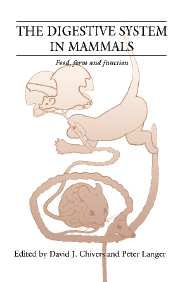Book contents
- Frontmatter
- Contents
- List of contributors
- Preface
- Part I Introduction
- Part II Food
- 5 Foods and the digestive system
- 6 Classification of foods for comparative analysis of the gastro-intestinal tract
- 7 The ‘carnivorous’ herbivores
- 8 Nutritional ecology of fruit-eating and flower-visiting birds and bats
- 9 Herbivory and niche partitioning
- 10 Taste discrimination and diet differentiation among New World primates
- 11 Potential hominid plant foods from woody species in semi-arid versus sub-humid sub-tropical Africa
- Part III Form
- Part IV Function
- Part V Synthesis and perspectives
- Index
5 - Foods and the digestive system
Published online by Cambridge University Press: 18 March 2010
- Frontmatter
- Contents
- List of contributors
- Preface
- Part I Introduction
- Part II Food
- 5 Foods and the digestive system
- 6 Classification of foods for comparative analysis of the gastro-intestinal tract
- 7 The ‘carnivorous’ herbivores
- 8 Nutritional ecology of fruit-eating and flower-visiting birds and bats
- 9 Herbivory and niche partitioning
- 10 Taste discrimination and diet differentiation among New World primates
- 11 Potential hominid plant foods from woody species in semi-arid versus sub-humid sub-tropical Africa
- Part III Form
- Part IV Function
- Part V Synthesis and perspectives
- Index
Summary
The structure and composition of the different parts of animals or plants (and, in a few instances, minerals) that are actually fed on by animal species result from long processes of interaction in the networks of past ecosystems where these species or their ancestors were present. Analysing the present status of ‘food species’ therefore involves taking a glimpse at this past, as does interpreting the adaptation of the form and function of the digestive tract of the consumers (Langer, Ch. 2).
Primate species and primate foods provide several examples in which recent investigations (presented in different chapters of this volume) have enabled us to understand these long-term processes, which also apply to other mammalian species. During the Mezozoic, when the continental plates were drifting apart (South and North America on one side, Africa and Eurasia on the other one), most plant species were quite different from those that we presently know, and, if we think of them as food, they probably also differed in terms of composition and taste. In parallel with the evolution of the Platyrrhini and Catarrhini primates, occurring on the west and east sides of the primitive Atlantic Ocean, the flowering plant species evolved in response to consumers and tended, simultaneously, to develop edible parts and nonedible parts.
Food edibility
Edible plant parts include leaves, exudates, tubers, fruits and seeds; the productive plant machinery (leaves), although needing to contain a diverse mixture of enzymes and co-enzymes and, therefore, containing a broad mix of essential amino acids and minerals, has most of its energy locked up in cellulose.
- Type
- Chapter
- Information
- The Digestive System in MammalsFood Form and Function, pp. 65 - 73Publisher: Cambridge University PressPrint publication year: 1994
- 6
- Cited by



